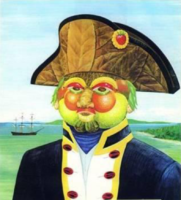Breadfruit and other Bounties
Was Bligh a forerunner of Johnny [Appleseed] Chapman? ‘In a strange mixture of tropical and temperate crops, the legend to this John Prezioso painting explains that this Bligh-like figure consists of northern fruits like the apple and peach (his eyelid and upper lip), as well as equatorial tree products such as the coconut, banana, mango, nutmeg, and the breadfruit (his forehead, eyebrow, upper cheeks, buttons, and jowls). Behind this colonial figure awaits the technology of transfer, a European ship.’
‘The posture of this excessively naturalized colonist replicates a Crusoe-esque “monarch-of-all-I-survey” with the important difference that the economic crops are removed from the landscape and are embedded in his face. This is a literal representation of uprooted, anthropomorphized nature, reducing food plants to their detachable post-harvest pieces, where bite-size slices of lemons, limes, peaches, and apples symbolize the dominance of European economic and bodily consumption. The physical prominence of tobacco (his hat) suggests this image has less to do with the aphorism “we are what we eat,” but rather “we are what we trade (and consume).” Like the author of the article, the artist naturalizes the British Empire as the patriarchal root of world modernity, the causal agent of historical bounty and its consumption. The painting cannot emphasize the mode of production because the plants are, after all, natural rather than man-made products. Thus the trader becomes a rather puffy-faced figure of consumption, expressing his modern identity through the constitutive parts of natural commodities around the globe. This image of natural (yet rootless) colonialism links Caribbean history with U.S. nationalism in a bicentennial tribute to “the sea captains […] who literally planted the seeds of modern nutrition all over the globe”.’ [Cit. DeLoughrey, Elizabeth 2008]



Comments are closed.